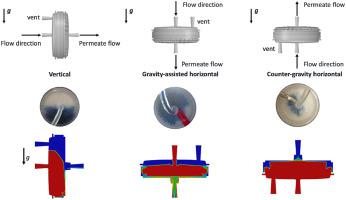当前位置:
X-MOL 学术
›
J. Membr. Sci.
›
论文详情
Our official English website, www.x-mol.net, welcomes your feedback! (Note: you will need to create a separate account there.)
Effect of density variations and buoyancy on flow in small-scale depth filter capsules
Journal of Membrane Science ( IF 9.5 ) Pub Date : 2024-04-08 , DOI: 10.1016/j.memsci.2024.122749 Mohammad Naghashnejad , Goli Ghajar , Lara Fernandez-Cerezo , David J. Roush , Ali Borhan , Andrew L. Zydney
Journal of Membrane Science ( IF 9.5 ) Pub Date : 2024-04-08 , DOI: 10.1016/j.memsci.2024.122749 Mohammad Naghashnejad , Goli Ghajar , Lara Fernandez-Cerezo , David J. Roush , Ali Borhan , Andrew L. Zydney

|
Depth filters are widely employed to clarify cell culture fluids in bioprocessing, with cells, cell debris, and intra- and extra-cellular impurities (e.g. DNA and host cell proteins) removed based on their size as well as adsorptive interactions within the depth of the porous media. Some large-scale depth filters are designed to operate with the filter media in a horizontal orientation, while others employ modules arranged with the filters oriented vertically. However, the potential impact of the filter orientation on flow and filtration performance has not previously been examined. In this work, a combination of experimental studies and computational fluid dynamics (CFD) were used to quantitatively evaluate the effect of density differences between the suspending media (buffer/deionized water) and the cell culture broth on the flow distribution and the fouling behavior of the Millistak+® HC Micro 20 depth filter. Dye visualization experiments showed that the flow fields depend significantly on the orientation of the depth filter with respect to gravity. The flow is highly asymmetric when the filter is operated in the vertical orientation (with feed flow directed perpendicular to gravity), while a symmetric flow pattern was found for filters oriented horizontally (feed flow aligned with or against gravity). The CFD analysis was in very good agreement with experimental results in all filter orientations. These results have significant implications in understanding the fouling behavior, scale-up, and separation efficiency of depth filters used in bioprocessing, including the impact of buoyancy-driven flows arising from the density differences between cells/cell debris and supernatant.
中文翻译:

密度变化和浮力对小型深度过滤胶囊中流动的影响
深度过滤器广泛用于澄清生物加工中的细胞培养液,根据细胞、细胞碎片以及细胞内和细胞外杂质(例如 DNA 和宿主细胞蛋白)的大小以及深度内的吸附相互作用来去除细胞、细胞碎片和细胞外杂质(例如 DNA 和宿主细胞蛋白)。多孔介质。一些大型深度过滤器设计为在水平方向上使用过滤介质进行操作,而另一些则采用以垂直方向排列的过滤器排列的模块。然而,之前尚未研究过过滤器方向对流量和过滤性能的潜在影响。在这项工作中,结合实验研究和计算流体动力学(CFD)来定量评估悬浮介质(缓冲液/去离子水)和细胞培养液之间的密度差异对流量分布和污垢行为的影响。 Millistak+® HC Micro 20 深层过滤器。染料可视化实验表明,流场很大程度上取决于深度过滤器相对于重力的方向。当过滤器在垂直方向上运行时(进料流垂直于重力方向),流动是高度不对称的,而水平方向上的过滤器(进料流与重力方向一致或相反)则发现对称的流动模式。 CFD 分析与所有过滤器方向的实验结果非常一致。这些结果对于理解生物加工中使用的深度过滤器的结垢行为、放大和分离效率具有重要意义,包括细胞/细胞碎片与上清液之间密度差异引起的浮力驱动流的影响。
更新日期:2024-04-08
中文翻译:

密度变化和浮力对小型深度过滤胶囊中流动的影响
深度过滤器广泛用于澄清生物加工中的细胞培养液,根据细胞、细胞碎片以及细胞内和细胞外杂质(例如 DNA 和宿主细胞蛋白)的大小以及深度内的吸附相互作用来去除细胞、细胞碎片和细胞外杂质(例如 DNA 和宿主细胞蛋白)。多孔介质。一些大型深度过滤器设计为在水平方向上使用过滤介质进行操作,而另一些则采用以垂直方向排列的过滤器排列的模块。然而,之前尚未研究过过滤器方向对流量和过滤性能的潜在影响。在这项工作中,结合实验研究和计算流体动力学(CFD)来定量评估悬浮介质(缓冲液/去离子水)和细胞培养液之间的密度差异对流量分布和污垢行为的影响。 Millistak+® HC Micro 20 深层过滤器。染料可视化实验表明,流场很大程度上取决于深度过滤器相对于重力的方向。当过滤器在垂直方向上运行时(进料流垂直于重力方向),流动是高度不对称的,而水平方向上的过滤器(进料流与重力方向一致或相反)则发现对称的流动模式。 CFD 分析与所有过滤器方向的实验结果非常一致。这些结果对于理解生物加工中使用的深度过滤器的结垢行为、放大和分离效率具有重要意义,包括细胞/细胞碎片与上清液之间密度差异引起的浮力驱动流的影响。



























 京公网安备 11010802027423号
京公网安备 11010802027423号